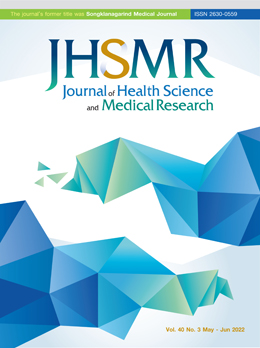Prevalence of Urinary Incontinence Among Hospital Based and Community Dwelling Women: A Survey
DOI:
https://doi.org/10.31584/jhsmr.2021837Keywords:
community dwelling women, musculo-skeletal conditions, prevalence, urinary incontinenceAbstract
Objective: The aim of this study was to determine the prevalence of urinary incontinence (UI) among hospital based patients and community dwelling women.
Material and Methods: This prevalence survey was conducted with 334 respondents, using the Medical Epidemiological and Social Aspects of Aging and Incontinence Severity Index questionnaire.
Results: UI was highly prevalent in hospital patients; 34.1% (n=57) compared to community dwelling women; 10.2% (n=17). This study’s findings determined a significant association of age along with the severity of UI among hospital based women, considering a p-value=0.030. In addition, this study illustrated a substantial association of musculo-skeletal conditions along with the severity of UI among hospital based women considering a p-value=0.018. Consequently, there was a significant association of musculo-skeletal conditions along with the severity of UI in community dwelling women (p-value=0.040).
Conclusion: Hospital based patients with musculoskeletal conditions predominantly suffered with UI more so than the community dwelling women. Further studies should be conducted to establish the reasons for the difference in ratios of UI among hospital based and community dwelling women.
References
Abrams P, Andersson KE, Birder L, Brubaker L, Cardozo L, Chapple C. Evaluation and treatment of urinary incontinence, pelvic organ prolapse, and fecal incontinence. Neurourol Urodyn 2010;29:213-40.
Haylen BT, De Ridder D, Freeman RM, Swift SE, Berghmans B, Lee J. An International Urogynecological Association (IUGA)/ International Continence Society (ICS) joint report on the terminology for female pelvic floor dysfunction. Neurourol Urodyn 2010;29:4-20.
Milsom I, Altman D, Cartwright R, Lapitan MC, Nelson R, Sill n U, et al. Epidemiology of urinary incontinence (UI) and other lower urinary tract symptoms (LUTS), pelvic organ prolapse (POP) and anal incontinence (AI). 5th ed. Paris: ICUD-EAU; 2012:p.15-107.
Eliasson K, Elfving B, Nordgren B, Mattsson E. Urinary incontinence in women with low back pain. Man Ther 2008;13: 206-12.
Turner-Stokes L, Frank AO. Urinary incontinence among patients with arthritis––A neglected disability. J R Soc Med 1992;85:389–93.
Ahmadi B, Alimohammadian M, Golestan B, Mahjubi B, Janani L, Mirzaei R. The hidden epidemic of urinary incontinence in women: A population-based study with emphasis on preventive strategies. Int Urogynecol J 2010;21:453–9.
Young AE, Fine PM, McCrery R, Wren PA, Richter HE, Brubaker L, et al. Pelvic Floor Disorders Network, Spanish language translation of pelvic floor disorders instruments. Int Urogynecol J 2007;18:1171-8.
Nipa SI, Sriboonreung T, Paungmali A, Phongnarisorn C. Linguistic Validation of Medical Epidemiological and Social Aspects of Aging Questionnaire in Bengali Language. Int J Linguistics Lit Trans 2019;2:220-6.
Sandvik H, Seim A, Vanvik A, Hunskaar S. A severity index for epidemiological surveys of female urinary incontinence: comparison with 48-hour pad-weighing tests. Neurourol Urodyn 2000;19:137-45.
Nipa SI, Sriboonreung T, Paungmali A, Phongnarisorn C. Linguistic Validation of Incontinence Severity Index (ISI) Questionnaire in Bengali Language. Int J Linguistics Lit Trans 2019;3: 39-45.
Herzog AR, Fultz NH. Prevalence and incidence of urinary incontinence in community-dwelling populations. J Am Geriatr Soc 1990;38:273-81.
Nipa SI, Kamal A, Shofiqul MI, Rahat KM, Farjana T. Prevalence of urinary incontinence among the women with low back pain: an institutional based study. Int J Adv Res 2017;1:143-50.
Milsom I. The prevalence of urinary incontinence. Acta Obstet Gynecol Scand 2000;79:1056-9.
Hampel C, Wienhold D, Benken N, Eggersmann C, Thüroff JW. Definition of overactive bladder and epidemiology of urinary incontinence. Urol 1997;50:4-14.
Thom D. Variation in estimates of urinary incontinence prevalence in the community: effects of differences in definition, population characteristics, and study type. J Am Geriatr Soc 1998;46: 473-80.
Minassian VA, Drutz HP, Al-Badr A. Urinary incontinence as a worldwide problem. Int J Gynecol Obst 2003;82:327-38.
Moulin MD, Hamers, JPH, Ambergen AW, Janssen MAP, Halfens RJG. Prevalence of urinary incontinence among communitydwelling adults receiving home care. Res Nurs Health 2008; 31:604-12.
Kim H, Yoshida H, Hu X, Saito K, Yoshida Y, Kim M. Association between self-reported urinary incontinence and musculoskeletal conditions in community-dwelling elderly women: A cross-sectional study. Neurourol Urodyn 2015;34: 322-6.
Downloads
Published
How to Cite
Issue
Section
License

This work is licensed under a Creative Commons Attribution-NonCommercial-NoDerivatives 4.0 International License.
























